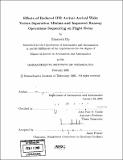| dc.contributor.advisor | John-Paul B. Clarke. | en_US |
| dc.contributor.author | Bly, Elizabeth, 1981- | en_US |
| dc.contributor.other | Massachusetts Institute of Technology. Dept. of Aeronautics and Astronautics. | en_US |
| dc.date.accessioned | 2005-09-27T18:59:42Z | |
| dc.date.available | 2005-09-27T18:59:42Z | |
| dc.date.copyright | 2005 | en_US |
| dc.date.issued | 2005 | en_US |
| dc.identifier.uri | http://hdl.handle.net/1721.1/28908 | |
| dc.description | Thesis (S.M.)--Massachusetts Institute of Technology, Dept. of Aeronautics and Astronautics, 2005. | en_US |
| dc.description | Includes bibliographical references (p. 99-101). | en_US |
| dc.description.abstract | (cont.) 65.6% and 67.0% and the average NAS delay by 24.3% and 24.7% relative to the FIFO and Serve-the-Longest-Queue algorithms respectively. | en_US |
| dc.description.abstract | Two methods to improve runway throughput are evaluated in this thesis. The first, increasing runway capacity during periods of bad weather by reducing IFR arrival-arrival wake vortex separations. The second, increasing runway efficiency in all weather conditions using event sequencing algorithms. Two algorithms were studied: a Serve-the-Longest-Queue algorithm for flight sequencing coupled with a greedy heuristic algorithm for runway assignment and a mixed integer programming optimization algorithm for simultaneous flight sequencing and runway assignment. The MIT Extensible Air Network Simulation (MEANS) was used to simulate NAS op- erations to determine the potential benefits in terms of delay reduction for both methods. For the case where reduced IFR arrival-arrival wake vortex separations was studied, the Airport Runway Capacity Calculator (ARCC), developed in support of this work, was used to determine the increased capacity at eleven congested US airports. Results indicate that the total delay in the National Airspace System (NAS) could have been reduced by 31.8% over the month of January, 1999 (a reduction of 243,672 minutes) representing a benefit of 116 minutes per IFR hour. For the cases where the event sequencing algorithms were studied, the algorithms were only implemented at Newark Airport (EWR) and the resulting delay values were compared to the performance of a FIFO algorithm that is representative of existing operations. The flight delay for the Serve-the-Longest-Queue algorithm and the FIFO algorithm were similar, though relative performance depended on the airline schedule. The integer programming optimization algorithm out performed the other two algorithms significantly reducing the average delay at EWR by | en_US |
| dc.description.statementofresponsibility | by Elizabeth Bly. | en_US |
| dc.format.extent | 101 p. | en_US |
| dc.format.extent | 4741959 bytes | |
| dc.format.extent | 4753765 bytes | |
| dc.format.mimetype | application/pdf | |
| dc.format.mimetype | application/pdf | |
| dc.language.iso | en_US | |
| dc.publisher | Massachusetts Institute of Technology | en_US |
| dc.rights | M.I.T. theses are protected by copyright. They may be viewed from this source for any purpose, but reproduction or distribution in any format is prohibited without written permission. See provided URL for inquiries about permission. | en_US |
| dc.rights.uri | http://dspace.mit.edu/handle/1721.1/7582 | |
| dc.subject | Aeronautics and Astronautics. | en_US |
| dc.title | Effects of reduced IFR arrival-arrival wake vortex separation minima and improved runaway operations sequencing on flight delay | en_US |
| dc.title.alternative | Effects of reduced instrumented flight rules arrival-arrival wake vortex separation minima and improved runaway operations sequencing on flight delay | en_US |
| dc.type | Thesis | en_US |
| dc.description.degree | S.M. | en_US |
| dc.contributor.department | Massachusetts Institute of Technology. Department of Aeronautics and Astronautics | |
| dc.identifier.oclc | 60494249 | en_US |
